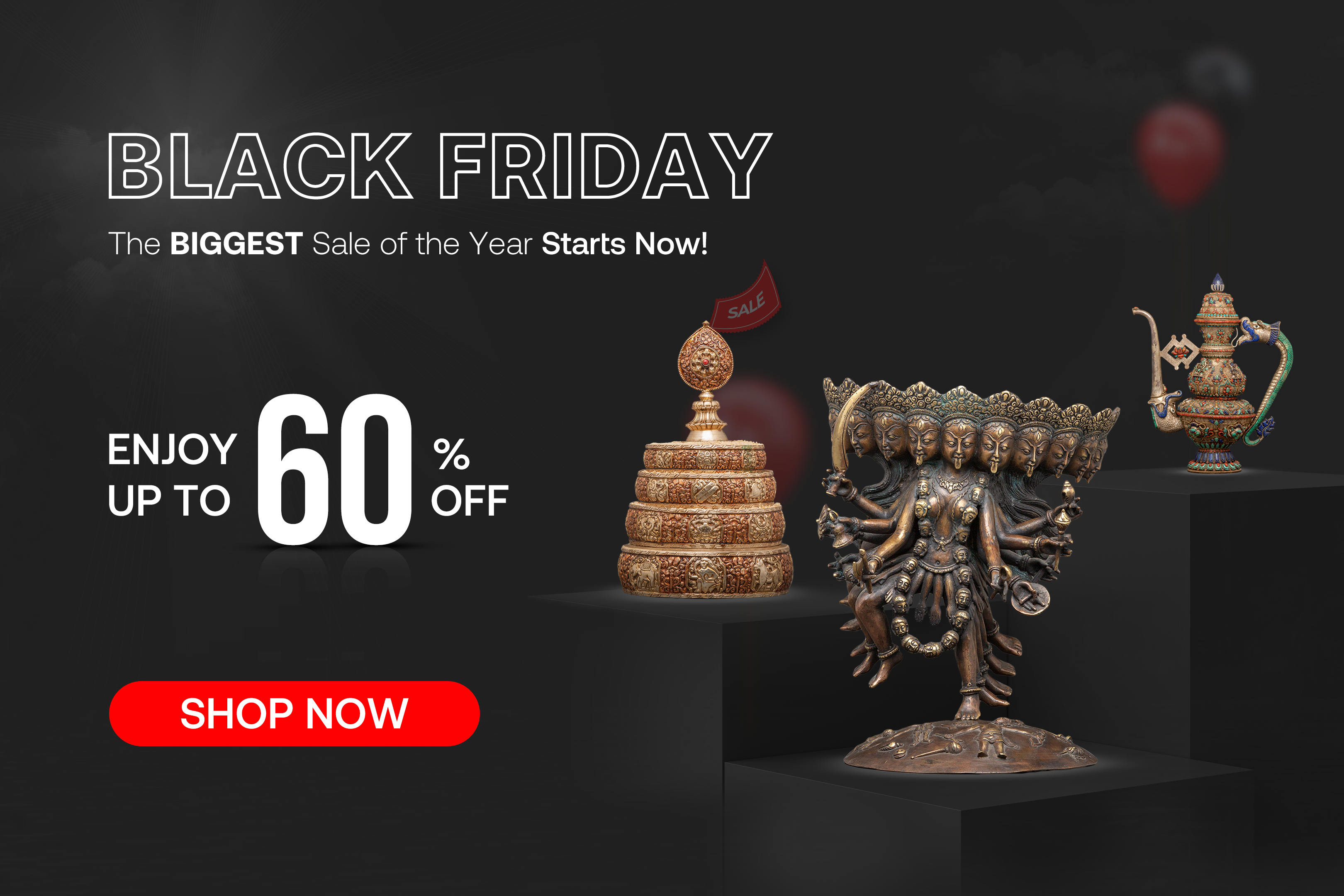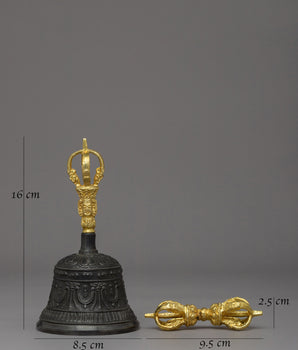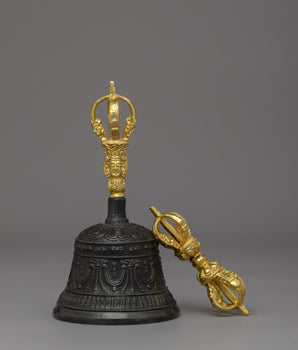Enlightenment Unleashed: Unveiling the Legacy of Guru Rinpoche
Guru Rinpoche, often referred to by many names such as 'Guru Padmasambhava,' 'Lotus Born Master,' and 'Buddha Of The Three Jewels,' is one of the founding fathers of Tibetan Buddhism. Guru Rinpoche translates to 'Precious Master .'He is considered to be the second Buddha.
Shakyamuni Buddha's Prophecy on Guru Rinpoche
According to legend, the emergence of Guru Padmasambhava was foreseen by Buddha Shakyamuni. His appearance and activity are explicitly predicted in 19 separate sutras and tantras. Buddha Shakyamuni informed the disciples of his mahaparinirvana in the Mahaparinirvana Sutra.
"Eight years after my mahaparinirvana, a remarkable being with the name Padmasambhava will appear in the center of a lotus and reveal the highest teaching concerning the ultimate state of true nature, bringing great benefit to all sentient beings."
– Buddha Shakyamuni
Birth Of Guru Rinpoche

Click here to view our High Quality Guru Rinpoche Statue
Guru Rinpoche, born with innate wisdom and compassion, exists to aid countless sentient beings. He resides in the Zangdok Palri Pure Land, where he initially manifested, appearing as a luminous form.
Twelve years after Buddha's Mahaparinirvana, the radiant blessing of the Buddha of Infinite Light struck a lotus in the Milk Ocean southwest of Bodhgaya. From this lotus birth emerged Guru Rinpoche, a miraculous birth devoid of human parents.
While journeying over the sea, King Indrabodhi of Oddiyana and his Ministers discovered the newborn Rinpoche. Welcomed into the Palace, he was enthroned as the Crown Prince.
During his youth, Padmasambhava underwent comprehensive training in various fields of knowledge, which he mastered. Despite this, he relinquished his royal life to dedicate himself to aiding sentient beings through esoteric wisdom and sacred prowess.
Being an enlightened Buddha, he stressed Dharma adherence and received teachings from Dakini, non-human deities, and human scholars. These teachings were then imparted to both visible and unseen entities innumerable. Through his indomitable might, he subdued numerous malevolent forces that obstructed his enlightening mission.
Guru Padmasambhava's Arrival in Tibet
He traveled to Tibet at the start of the ninth century at King Trisong Deutsen's invitation, introducing Buddhism to Tibet for the first time. His journey to Tibet and other Himalayan regions had three primary purposes:
First, Guru Rinpoche subdued both living and non-living creatures that were impeding the construction of the Samye Monastery and the spread of Buddhism in Tibet. On the peak of Hepo Mountain, not far from Samye Monastery, the deity battled the spirit forces and bonded them to swear allegiance to the Dharma and its adherents.
Additionally, he appeared as Dorje Drolö, a furious form of Guru Rinpoche, in the Taktsang cave in Bhutan, where he defeated the evil spirit forces.
Second, he imparted Vajrayana's wisdom to many outstanding followers and hundreds of additional teachings. Highly enlightened adepts have preserved the uninterrupted lineages of those transmissions for centuries, and they continue to flourish now. These lineages are extensively dispersed across the globe in the modern era.
He visited Tibet's valleys, Nepal, Bhutan, and Sikkim, and he bestowed the "Sacred Land" title upon them. Even more astoundingly, as he taught his followers these esoteric truths, he mysteriously hid them in the innocence of their minds.
Then he hid several religious artifacts and symbolic writings in various locations, including rocks, statues, lakes, and outer space. These are referred to as his Ter (Hidden Treasure Teachings).
The Pure Land Of Lotus Born Master

Click here to view our Guru Padmasambhava Thangka
Padmasambhava transformed his physical body into "the rainbow-light-body of great transference" by meditating on Dzogpa Chenpo.
He declared his departure for the lands of the rakshas after living in Tibet for almost 55 years. He bid farewell to King Mutig Tsenpo and the gathered Tibetan believers on the Gongthang pass in Western Tibet.
The dakinis and celestial creatures with flowers, banners, and music suddenly arrived as Guru Padmasambhava looked up towards the sky, together with a stunning blue horse decked out in jewels.
In front of everyone, he flew through the skies on the horse. After touching down in Zangdok Palri, he emitted the Lotus Light Palace as a Manifested Pure Land.
He remains in Zangdok Palri as a "rainbow-light-body of great transference" along with many Enlightened Ones and his countless devoted followers. He continues to possess the characteristics of the Ultimate-body, the Enjoyment-body, and the manifestation of the Manifested-bodies of Buddhahood.
Rainbow Body of the Buddha Padmasambhava

The Vajra Rainbow Body ('ja' lus rdo rje'i sku), also known as the Rainbow Body, is derived from the Tibetan words lus (that which is left behind, ordinary body) and 'ja' (rainbow, rainbow hue).
It is more of an energy vortex than a physical "body," into which some adepts are said to be able to transition when they pass away.
Legend has it that when Guru Rinpoche passed away, he had attained the Rainbow Body, dissolving his physical body into light and leaving just his hair, nails, and garments behind.
Guru Rinpoche's path toward the Rainbow Body began when he received spiritual guidance from his teacher Shri Singha. After many years of diligent effort and meditation, Guru Rinpoche gained a profound realization and enlightenment.
He is claimed to have practiced diligently for many years to achieve the rainbow body, including the development of commitment, the cultivation of the four foundations of mindfulness, and the practice of Dzogchen, which is thought to be the most effective method.
Many more practitioners have stated to have been inspired by this miraculous occurrence to pursue the rainbow body through their spiritual practice.
8 Manifestation of the Padmasambhava
The most generous deeds Guru Rinpoche has performed for the benefit of all creatures are exemplified in The Eight Emanations.
They are a prime example of the astonishing adaptability of actual nature, which permits everything to express and undergo constant change without conforming to rigid forms or dogmas. This adaptability illustrates how Guru Rinpoche's enlightened practices have limitless possibilities.
The Eight Manifestations of Padmasambhava represent his ability to appear in accordance with different needs and demands rather than showing separate Padmasambhavas.
In reality, they are known as the eight 'names' of the Guru in Tibetan, or Guru Tsen Gyé; each appearance exemplifies a different principle that reveals the true nature of consciousness.
"Mind itself is Padmasambhava; there is no practice or meditation apart from that,"
Guru Rinpoche stated.
-
Guru Tsokyé Dorje (Lake-born Vajra)- Peaceful Form Of the Deity
When Guru was 8 years
-
Guru Shakya Sengé (Lake-born Vajra)- A Self- Manifested Buddha
During his ordination
-
Guru Nyima Özer ('Rays of the Sun)
Subjugating demonic spirits
-
Guru Padmasambhava (Lotus Born)- Guru Pema Jungné
During the 8th century, establishing Buddhism in Tibet
-
Guru Loden Choksé (Wise Seeker of the Sublime)
For Mastery Of The Teachings
-
Guru Pema Gyalpo ('The Lotus King)- King Of Tripitaka
During his kingship
-
Guru Sengé Dradrok (The Lion's Roar)
After leaving the kingdom
-
Guru Dorje Drolö (Wild Wrathful Vajra)
Concealing Terma, binding spirits under oath
Mantra Of Guru Rinpoche (Vajra Guru Mantra)
“Om Ah Hum Vajra Guru Padma Siddhi Hum”
The mantra is believed to be a highly effective way to remove obstacles and negative karma and invoke the Guru's blessings. It is claimed to encompass the essence of Padmasambhava's teachings and prayers.
The Vajra Guru mantra is said to have been imparted by Padmasambhava to invoke his protection and blessings. Many great masters throughout Tibetan history are reported to have used the Vajra Guru mantra, which is also said to have been passed down through many lineage masters.
- OM- Represents Body
- AH- Signifies Speech
- HUM (HUNG)- Symbolizes Mind
- VAJRA: It is a manifestation of enlightened wisdom and compassion in their most pure form. According to the Dharmakaya element of the Buddha—a transcendent divinity that embodies the ultimate truth
- GURU: The Sambhogakaya element of the Buddha, also known as the "bliss" or "enjoyment" body, is reflected in GURU.
- PADME: Following the Nirmanakaya element of the Buddha's physical body linked with the lotus family, PADME represents the enlightened mind unencumbered by ignorance.
- SIDDHI: Symbolizes attainment, realization, achievement, and grace.
Each syllable purifies the obscuration of
OM AH HUM: Three Metal Poisons
VAJRA: Hatred & Aversion
GURU: Pride
PADME: Craving & Attachment
SIDDHI: Jealously
Iconography Of the Legendary Master

Guru Rinpoche's thangkas are exceptionally detailed. It has excellent detail and is ichnographically precise. In most of the thangkas of Padmasambhava, he is depicted sitting in the middle with his legs crossed, holding a vajra in his right hand and a skull cup full of nectar in his left. It houses the vase of longevity, further flowing with the wisdom nectar of eternity.
His tantric hat features the Sun and Crescent Moon, symbols of his yogic accomplishments. His Great Perfection is symbolized by the eagle feather that rises above. The jewel in his Tantric crown is Dzogchen.
In certain thangkas, Guru Padmasambhava is portrayed in the middle of a deep blue lake with his principal consorts, Yeshe Tsogyal and Mandarava. While Queen Yeshe Tsogyal is from Tibet, Princess Mandarava is from India.















